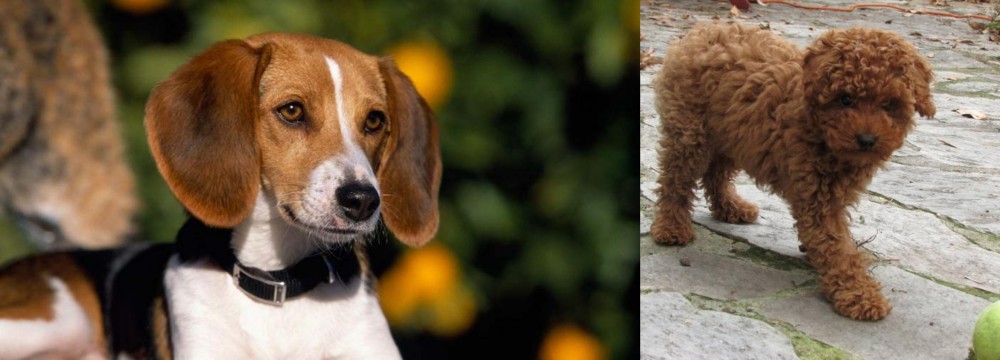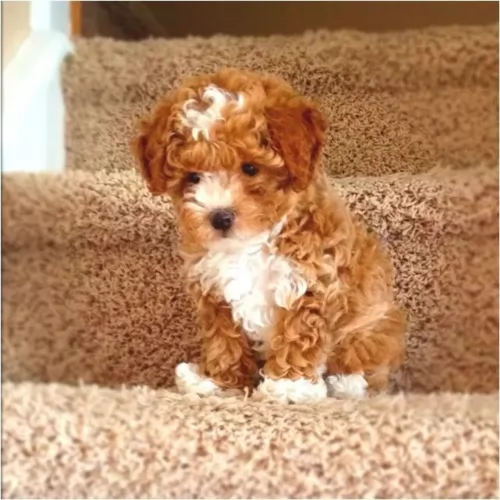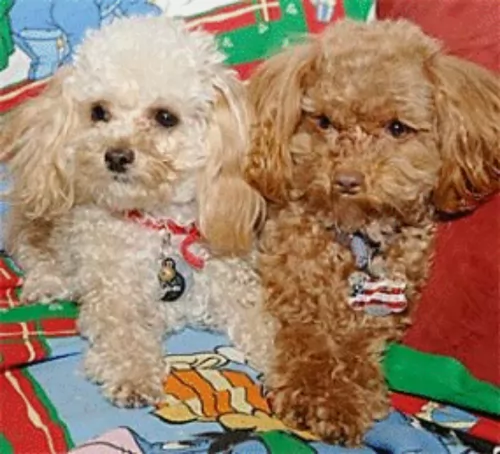 Petzlover
Petzlover American Foxhound is originated from United States but Toy Poodle is originated from France. American Foxhound may grow 36 cm / 15 inches higher than Toy Poodle. American Foxhound may weigh 27 kg / 60 pounds more than Toy Poodle. American Foxhound may live 3 years less than Toy Poodle. American Foxhound may have more litter size than Toy Poodle. American Foxhound requires Low Maintenance. But Toy Poodle requires Moderate Maintenance
American Foxhound is originated from United States but Toy Poodle is originated from France. American Foxhound may grow 36 cm / 15 inches higher than Toy Poodle. American Foxhound may weigh 27 kg / 60 pounds more than Toy Poodle. American Foxhound may live 3 years less than Toy Poodle. American Foxhound may have more litter size than Toy Poodle. American Foxhound requires Low Maintenance. But Toy Poodle requires Moderate Maintenance
 As a cousin of the English Foxhound, the American Foxhound is a scent hound and bred for hunting. Robert Brooke brought the first hunting dogs to the colonies in 1650. These dogs were the starting point for several American hound breeds including the American Foxhound.
As a cousin of the English Foxhound, the American Foxhound is a scent hound and bred for hunting. Robert Brooke brought the first hunting dogs to the colonies in 1650. These dogs were the starting point for several American hound breeds including the American Foxhound.
For almost 300 years the Brooke family owned and bred dogs from this bloodline.
At the same time that Brooke was hunting with and breeding his hounds, George Washington was given French Foxhounds. These were crossed with the Brooke’s dogs to create the American Foxhound. This breed is said to have been originally bred in Virginia and Maryland.
They are the state dog of Virginia. After Red Foxes were imported or migrated, Irish Foxhounds were brought to American and added into the line, increasing the stamina and speed that today’s dog’s still display.
The American Foxhound was recognized by the American Kennel Club in 1886. Today’s American Foxhound presents in many different lines but are all considered the same breed even though some ay look very different. These strains include the Trigg, Walker, Penn-Marydel, Goodman, July and Calhoun.
 More and more people are opting not to clip their Poodles ith those ridiculous hair cuts with pom poms. Clipped properly, he can be just as cute as any other dog.
More and more people are opting not to clip their Poodles ith those ridiculous hair cuts with pom poms. Clipped properly, he can be just as cute as any other dog.
It is thought that the Toy Poodle hails from France, with the standard poodle having originated in Germany. The first poodles were used as herders so they’re not just useless dogs with silly pom-pom haircuts.
Some rough-coated water dogs are believed to be ancestors of the Poodle. It was in the 19th century that these dogs became show dogs. Their popularity died out in the 1920s, but it has once again become a popular dog.
 Given the variety of bloodlines and strains mentioned above, there can be many differences in the American Foxhounds. Because of this most American Foxhounds bred to show are Walkers as they most closely fit the AKC Breed Standard.
Given the variety of bloodlines and strains mentioned above, there can be many differences in the American Foxhounds. Because of this most American Foxhounds bred to show are Walkers as they most closely fit the AKC Breed Standard.
In general, the American Foxhound has long, straight legs and is taller than the English Foxhound. They have a narrow chest and domed skull with a long muzzle.
They have low, wide set eyes that should be dark – brown or hazel, never blue. They have feet like a fox and laid-back shoulders with a curved tail. Athletic and muscled, the American Foxhound is bred to run. They are one of the rarest breeds in the United States.
 Toy Poodles stand between 24 to 28 cm in height and weigh in the region of 2 to 5kg. Poodles are light-shedding dogs and are thought to be hypo-allergenic. If you have an allergy, a Toy Poodle can e a great dog for you.
Toy Poodles stand between 24 to 28 cm in height and weigh in the region of 2 to 5kg. Poodles are light-shedding dogs and are thought to be hypo-allergenic. If you have an allergy, a Toy Poodle can e a great dog for you.
The crip, curly coat comes in a number of colors – cream, apricot, brown, chocolate, and black and he can be clipped if you find that he is too high maintenance. If the hair is allowed to grow it can become very matted and turn into dreadlocks.
Many Toy Poodle owners find this very difficult to maintain and opt to have the dog’s hair clipped. The poodle has medium-length floppy ears. Docking of the tail is important if you want to keep the distinctive look of your poodle. Fortunately, docking is still permitted in the USA and this is best done when the puppy is very young.
Toy Poodles are intelligent dogs and are capable of learning a whole lot of commands and tricks. They’re also excellent athletes, being lively and energetic.
Being lively and alert, the Toy Poodle can be a good watchdog too, barking sharply at intruders. The Toy Poodle is very social and won’t take kindly to being left alone for hours.
Then again, he is gentle and sensitive and won’t do well with undisciplined children and their shrill screams. They are definitely dogs that want peace and harmony. And having him trained and socialized will get you a well mannered, obedient dog. He is small enough to adapt to life in the city or the countryside.
 With a reputation as a docile, sweet dog, the American Foxhound is great with kids and animals. They are gentle and often very shy with strangers. They are strong willed and stubborn especially when training them, so they are not a good first dog. They need an owner who has handled dogs before and knows how to be the pack leader without being angry or mean.
With a reputation as a docile, sweet dog, the American Foxhound is great with kids and animals. They are gentle and often very shy with strangers. They are strong willed and stubborn especially when training them, so they are not a good first dog. They need an owner who has handled dogs before and knows how to be the pack leader without being angry or mean.
The American Foxhound is a scent hound and once he is on the scent it is close to impossible to distract him from it. They have a tendency to ignore commands when they are in this state. A strong owner/leader is needed for this reason. Don’t let him off leash in an unfenced area.
 This dog breed is very loyal to its family. It doesn't do well when left for hours on its own.
This dog breed is very loyal to its family. It doesn't do well when left for hours on its own.
Energetic and lively, you’ll find your Toy Poodle such a pleasure to have around. He is very intelligent too, so with training and socialization he becomes a super little pet.
Playful and social, he is like a small ray of sunshine that comes into your home and your heart.
 The American Foxhound, like most hunting dogs does not carry a lot of genetic disorders. But they can easily become overweight and this can cause major problems. Dysplasia of any type had been mostly unknown in this breed, but due to obesity it is cropping up on occasion. Breeders have not, and do not usually screed for any genetic diseases.
The American Foxhound, like most hunting dogs does not carry a lot of genetic disorders. But they can easily become overweight and this can cause major problems. Dysplasia of any type had been mostly unknown in this breed, but due to obesity it is cropping up on occasion. Breeders have not, and do not usually screed for any genetic diseases.
The most devastating health issue the American Foxhound faces is thrombocytopathy. We will go into more detail on this in the Care for Pet section. This is a disease of the blood system, namely the platelets.
 Good food and exercise keep the Toy Poodle as healthy as possible, but like other dogs, the Toy Poodle can also get sick. Cancer, bloat, ear infections, and obesity are common dog ailments.
Good food and exercise keep the Toy Poodle as healthy as possible, but like other dogs, the Toy Poodle can also get sick. Cancer, bloat, ear infections, and obesity are common dog ailments.
Too many dog owners don’t realize the importance of healthy teeth. You need to look into the mouth of your pet regularly to make sure there are no rotting teeth. These problematic teeth can jeopardize the health of your pet.
Infection of teeth and gums can cause a host of other problems such as kidney and heart disease.
Check your Toy Poodle for parasites – fleas, ticks, worms as these can take a toll on your pet’s health. Your pet can become lethargic and the coat becomes listless, thin and dull. Your pet will also lose weight. Speak to your vet about treatments that can prevent these infestations.
 Whether feeding a pup, or an adult American Foxhound, you need to be sure the food is high quality and that you don’t overfeed. The Foxhound is happy to eat as much as you give him. They like to eat. Make sure you measure and don’t free feed. Control what they are eating.
Whether feeding a pup, or an adult American Foxhound, you need to be sure the food is high quality and that you don’t overfeed. The Foxhound is happy to eat as much as you give him. They like to eat. Make sure you measure and don’t free feed. Control what they are eating.
For a puppy feed twice, a day – 2 to 3 cups of high quality puppy food. When he becomes an adult feed him once a day with 2 cups of adult food.
As mentioned previously, the American English Foxhound, like most of the hound breeds is a very healthy dog. They do not have many genetic health issues. They do have a risk for thrombocytopathy. This risk is slight, but all owners of American English Foxhounds should be aware of it.
This disease is a circulatory system disease with poorly or non-functioning platelets. Platelets are designed to assist in the control of bleeding and without functioning ones the dog can bleed excessively from just a minor cut or bleed internally from a minor injury. The disease can be treated but you have to notice it first. Depending on how severe the disease is, the treatment will vary. Some dogs will have to be given platelets.
This is a high energy breed that is very active and needs a lot of exercise. They are not good for the first-time owner as they are stubborn and hard to train. They need room to run and get frustrated and out of sorts if they don’t have it. They can live in the suburbs but only with a large fenced yard, an even larger dog park and regular walks. This dog needs a lot of exercise. The simplest thing to do is take him hunting.
 Make sure to exercise your Toy Poodle every day. If you’re lucky to have a garden, play ball games with him, play hide and seek and take him for walks.
Make sure to exercise your Toy Poodle every day. If you’re lucky to have a garden, play ball games with him, play hide and seek and take him for walks.
Brush your Toy Poodle twice a week. His curly coat can become a source of concern for you and then you can have his coat clipped short.
Provide your pet with training and socialization and get him used to walking on a leash.
Take your Toy Poodle for regular visits to the vet. There are some serious canine diseases that can kill your pet.
Provide your pet with a nice dry, peaceful sleeping area. He needs his own water and food bowls. Wash these regularly.
Provide your Toy Poodle with the best dog food there is. Try and go for natural foods free from colorants and fillers. Try and also give him some home-made food such as boiled chicken, brown rice, sweet potatoes, and spinach. Dogs like the same good foods which are simple and nutritious.